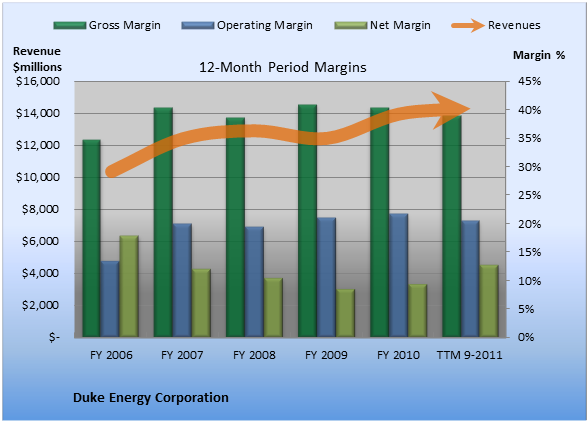Is Duke Energy Good Enough for You?
Margins matter. The more Duke Energy (NYS: DUK) keeps of each buck it earns in revenue, the more money it has to invest in growth, fund new strategic plans, or (gasp!) distribute to shareholders. Healthy margins often separate pretenders from the best stocks in the market. That's why we check up on margins at least once a quarter in this series. I'm looking for the absolute numbers, comparisons to sector peers and competitors, and any trend that may tell me how strong Duke Energy's competitive position could be.
Here's the current margin snapshot for Duke Energy and some of its sector and industry peers and direct competitors.
Duke Energy | 39.0% | 20.6% | 12.9% |
American Electric Power (NYS: AEP) | 36.4% | 20.0% | 12.0% |
Southern Co. (NYS: SO) | 37.6% | 23.2% | 11.8% |
Xcel Energy (NYS: XEL) | 31.2% | 16.5% | 7.9% |
Source: S&P Capital IQ. TTM = trailing 12 months.
Unfortunately, that table doesn't tell us much about where Duke Energy has been, or where it's going. A company with rising gross and operating margins often fuels its growth by increasing demand for its products. If it sells more units while keeping costs in check, its profitability increases. Conversely, a company with gross margins that inch downward over time is often losing out to competition, and possibly engaging in a race to the bottom on prices. If it can't make up for this problem by cutting costs -- and most companies can't -- then both the business and its shares face a decidedly bleak outlook.
Of course, over the short term, the kind of economic shocks we recently experienced can drastically affect a company's profitability. That's why I like to look at five fiscal years' worth of margins, along with the results for the trailing 12 months, the last fiscal year, and last fiscal quarter. You can't always reach a hard conclusion about your company's health, but you can better understand what to expect, and what to watch.
Here's the margin picture for Duke Energy over the past few years.

Source: S&P Capital IQ. Dollar amounts in millions. FY = fiscal year. TTM = trailing 12 months.
Because of seasonality in some businesses, the numbers for the last period on the right -- the TTM figures -- aren't always comparable to the FY results preceding them. Here's how the stats break down:
Over the past five years, gross margin peaked at 41% and averaged 39.1%. Operating margin peaked at 21.7% and averaged 19.2%. Net margin peaked at 17.9% and averaged 11.7%.
TTM gross margin is 39%, 10 basis points worse than the five-year average. TTM operating margin is 20.6%, 140 basis points better than the five-year average. TTM net margin is 12.9%, 120 basis points better than the five-year average.
With recent TTM operating margins exceeding historical averages, Duke Energy looks like it is doing fine.
If you take the time to read past the headlines and crack a filing now and then, you're probably ahead of 95% of the market's individual investors. To stay ahead, learn more about how I use analysis like this to help me uncover the best returns in the stock market. Got an opinion on the margins at Duke Energy? Let us know in the comments below.
Add Duke Energy to My Watchlist.
Add American Electric Power to My Watchlist.
Add Southern to My Watchlist.
Add Xcel Energy to My Watchlist.
At the time thisarticle was published Seth Jayson owned shares of the following at the time of publication: Southern Co. You can view his stock holdings here. He is co-advisor ofMotley Fool Hidden Gems, which provides new small-cap ideas every month, backed by a real-money portfolio. Motley Fool newsletter services have recommended buying shares of Southern. Try any of our Foolish newsletter services free for 30 days. We Fools may not all hold the same opinions, but we all believe that considering a diverse range of insights makes us better investors. The Motley Fool has a disclosure policy.
Copyright © 1995 - 2011 The Motley Fool, LLC. All rights reserved. The Motley Fool has a disclosure policy.

